

|
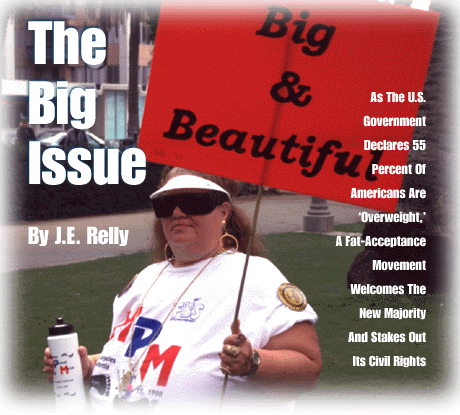
SANTA MONICA, CALIF., Aug. 15--At a nearby pier, tourists
are posing with a cardboard cutout of bikini-clad supermodel Cindy
Crawford. The sun is burning through the last of the coastal fog
as five luxury buses glide to a halt and unload more than 200
fat-rights activists onto Ocean Avenue's Palisades Park.
Even the most seasoned activists are jittery about potential
fat-bashing at their upcoming event, the Million-Pound March,
brainchild of Haley Hertz and Marilyn Wann, the outspoken publisher
of Fat!So? 'zine.
Weeks before this event, the hot pink-haired Wann said, "I
want Americans to see a big, fat crowd of people who claim their
pounds." She reasoned the humor in those words would attract
more attention than three million pleading or analytical ones.
 And Wann is right. As the two-hour march--well, actually more
of a rally--begins underneath the park's shade trees, national
and international journalists edge around red plastic signs printed
with defiant messages: "A woman of size who doesn't apologize!!!"
"A waist is a terrible thing to mind." "Fat is
Phat!"
And Wann is right. As the two-hour march--well, actually more
of a rally--begins underneath the park's shade trees, national
and international journalists edge around red plastic signs printed
with defiant messages: "A woman of size who doesn't apologize!!!"
"A waist is a terrible thing to mind." "Fat is
Phat!"
The protesters are an eclectic assemblage of attorneys, psychologists,
professors, researchers, teachers, sales reps, secretaries, clerks,
house fraus--some fat, some thinner. Some wear the scars of stomach
stapling and intestinal-bypass surgery; others have been turned
away from renting, insurance policies, exercise equipment at the
gym, and jobs that have a "fat ceiling" or require "front-office
appearance." Many share the childhood baggage of not fitting
in classroom desks or carrying Metracal in their tin lunch boxes.
"2-4-6-8. We do not regurgitate!"
Speaker after speaker steps up to the mike. Amazonian actress
Camryn Manheim charges that a script for her love interest on
ABC's The Practice was sanitized to a mere reference because
of her size. That is, until she reminded her producers of the
show's promo, where two svelte colleagues fell practically naked
out of the shower, kissing. "They told me, 'No, no, no, that's
not what it's about.' I said, 'That's exactly what it's about.'
I told them, 'I want a kiss, and I want it with tongue.' "
At this very moment, according to surveys, more than half of
the U.S. population is trying to lose weight.
"We waste $40 billion each year on the diet industry trying
to be thin," Wann's voice blares through the speakers. "Hoping
to be thin is not hope, it's hatred."
Among the celebrants of fat lib, there are no promotions of weight-loss
plans or magic-bullet diet drugs. In fact, if any research is
quoted, it's the research refuting the success rate of diets.
The establishment cures have been tried by an astounding percentage
of this group, most of whom have failed. For this, the non-profit
National Association to Advance Fat Acceptance (NAAFA) takes many
sacred cows to task, deconstructing each weight-related study
for bad science, scrutinizing the approval process of appetite-suppressant
drugs, exposing pharmaceutical-industry links to researchers.
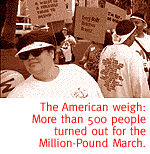 "We're fat, we're mean. We don't eat Lean Cuisine,"
participants chant.
"We're fat, we're mean. We don't eat Lean Cuisine,"
participants chant.
As politically astute Sally Smith, executive director of the
5,000-member human-rights organization, reads through her lines,
she facetiously tosses a jab at the National Institutes of Health
for recently redefining "overweight" from a body mass
index of 27 to 25. Suddenly overnight, "there are 25 million
more fat Americans," she says as the cheers overpower her
sardonic tone. "To that we say, welcome to the club. This
means very significantly that we now constitute 55 percent of
the population."
THE SIX-DAY CONVENTION attended by some 500 people offers
relief from typical American anti-fat demagoguery. Organizers
have forgotten no details, not even spatial ones: armless dining
room chairs; extra towels and water; a partially drained pool
for large groups of volleyball players and aerobics classes.
Even the temperature will be dropped a few degrees in the Westin
Hotel's conference rooms for more than 50 workshops and activities,
ranging from "Fat Self-Esteem 101" to "Obtaining
Quality Healthcare" to "Caring for Parents Who Once
Made Us Miserable" to belly dancing by the Fatimas troupe.
The hotel provisos allow 400- and 500-pound women to frolic in
the pool wearing bikinis and thong bathing suits if they wish,
without worrying about cameras and ugly stares. (In the past,
NAAFA allowed film crews and photographers on site to cover the
activism. But exploitative images sold around the world made the
press persona non grata at poolside and in the dining room.)
Jennifer Utken, a longtime fat activist from Tucson, remembers
her first pool experience at a NAAFA convention four years ago.
"We didn't grab towels to wrap around us when we got out.
It was total, unconscious, pure joy."
IT'S BEEN 29 years since New Yorker Bill Fabrey co-founded
NAAFA. A thin man, Fabrey was disturbed by the weight discrimination
that his large wife faced. He gathered a group of friends and
associates, and with Llewellyn Louderback, author of Fat Power,
and seven others, Fabrey attracted 100 members to the cause. This
in an era when there were virtually no legal precedents for size-related
discrimination cases and few options for XXXL clothes. Four years
later, Susie Orbach's 1973 bestseller Fat is a Feminist Issue
hit the stands. In 1977, Michigan enacted the Elliott-Larsen Civil
Rights Act, which remains the only state statute prohibiting discrimination
on the basis of height and weight, although lawmakers in Texas,
Massachusetts and New York have unsuccessfully introduced size
as a protected category in those states' civil-rights laws.
In the first years of the movement, Judy Freespirit, now a salt-and-pepper-haired
62, says NAAFA politics were lukewarm, but a core group kept the
activism churning. Looking back, Freespirit says changes weren't
happening fast enough, so she broke away from NAAFA and co-founded
The Fat Underground in Los Angeles.
"It was like the Black Panthers working with the NAACP,"
she says of the old factions within NAAFA. "Their idea of
activism was to go to the Cerebral Palsy Foundation and do volunteer
work so that people would say that fat people are nice. Ours was
to demonstrate--break into a university lecture hall at UCLA during
a class on behavior modification (for weight loss) and take over
the classroom."
"It was radical in the early years of this movement to say
people shouldn't be dieting," says Freespirit, who, with
her self-described radical-feminist colleagues, gathered the scarce
data demonstrating that people often gain more weight after dieting
than they've lost. "There were whole chapters of NAAFA getting
stomach bypasses and stapling in the late '70s." Today, the
organization has a four-page platform condemning the surgeries.
Since NAAFA originated, it's always been a clearinghouse for
fighting size discrimination. Yet politically active members say
it's only been with Sally Smith and President Frances White at
the helm, in the last decade, that the movement, with a $225,000
annual budget, has taken on the big issues. Last fall, NAAFA filed
a class-action suit against high-power players like Health and
Human Services head Donna Shallala, the Food and Drug Administration
and 10 pharmaceutical companies, seeking a recall of the diet
drugs Redux and fen-phen after numerous health problems surfaced.
Within the week, the drug was yanked from the market.
Smith says NAAFA representatives testify at FDA and National
Institute of Health hearings which set public policy, but their
inclusion is still token. At least 200 NAAFA members demonstrated
at the White House, voicing concern with the Clinton Administration's
healthcare reform plan after hearing that a few congressmen discussed
penalizing fat people. (Withholding benefits from fat people is
gaining popularity, with Texas Instruments and U-Haul among dozens
of companies that have employed the practice, commonly referred
to as "lifestyle discrimination." Smith, whose former
employment includes the American Civil Liberties Union, sounds
like gay-rights activists fighting back when she says, "We
don't consider our size a lifestyle.")
Under the giant tent of fat activism, NAAFA, albeit the largest
in the states, is only one of dozens of fat action groups. Yet
with more than one in two Americans considered "overweight"
by government standards, it's curious that, say for example in
Arizona, NAAFA claims only 26 members.
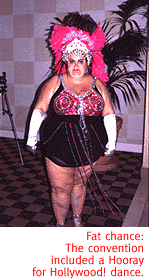 Esther Rothblum, an associate professor of psychology at the
University of Vermont, whose academic research has included size
discrimination in the workplace, reasons that fat people aren't
banding together in record numbers because, unlike external forms
of oppression such as racism, they suffer not only from societal
ridicule, but from internal guilt as well. Author and legal consultant
Sandra Solovay agrees: "For many fat people, self-hatred
runs so deep that they're not willing to stand up and 'come out'
as fat--they just want to be invisible."
Esther Rothblum, an associate professor of psychology at the
University of Vermont, whose academic research has included size
discrimination in the workplace, reasons that fat people aren't
banding together in record numbers because, unlike external forms
of oppression such as racism, they suffer not only from societal
ridicule, but from internal guilt as well. Author and legal consultant
Sandra Solovay agrees: "For many fat people, self-hatred
runs so deep that they're not willing to stand up and 'come out'
as fat--they just want to be invisible."
Some of the passivism is regional. In the San Francisco Bay area,
for example, there are so many fat-acceptance activist interests
that network meetings are necessary to prevent events from overlapping.
There's Fat Lip Reader's Theater, featuring scripts that are always
focused around fat; Hot Lips, another theatre group, highlights
fat and sex; and then there's Fat!So?, the 'zine for people
who don't apologize for their size; the newsletter Baby Baby;
FaT GiRL 'zine, The Big ad, a bi-monthly magazine
for full-framed gay men; Radiance magazine, along with
the Bay area NAAFA Chapter.
Within NAAFA, membership is a heady mix of special-interest groups,
or SIGS, from the Military Issues SIG to the Big Men's Forum SIG
to the Lesbian Fat Activist Network to the Parents and Caregivers
of Fat Children SIG. And NAAFA members are fanning out around
the country to 300 U.S. classrooms to preach the language of fat
acceptance. Then there's the Fat Women's Feminist Caucus, for
example, formed 15 years ago, in response to the "sexism
and heterosexism within the (NAAFA) organization," says chairwoman
Judy Freespirit.
The sub-group for the heaviest women within NAAFA, at 300-plus
pounds, is the Super SIG. Laura Baker, a soft-spoken member of
that sub-group, says they formed "out of the need for a safe
place to talk about issues (including mobility, personal hygiene
and clothing, among others) that some of our smaller sisters don't
have."
Strangely, even autopsies and burials should be added to the
list of problems. Michael Cardoza, an attorney for Marlene Corrigan,
whose 680-pound daughter's death precipitated a child-abuse proceeding
against her, says the coroner didn't do a complete autopsy of
the girl because of her size. "He did a 10-minute gross autopsy,
walked around the body. He said she died from morbid obesity,"
which didn't help her mother's criminal case, which fat-rights
attorneys say resulted from a string of fat-prejudicial decisions
starting with the police.
AS THE AWARDS-LUNCHEON participants trickle out into the
lobby, a California attendee mentions that she doesn't consider
guest speaker Laura Fraser fat. The slightly fleshy author of
Losing It: America's Obsession with Weight and the Industry
that Feeds on It, who counted calories in kindergarten and
spent years struggling inside the grip of bulimia, doesn't fit
the fat stereotype, but NAAFA's policy is to take in everyone.
Nearly 25 percent of the membership includes supporters--people
who are not fat.
"Theoretically, people (in NAAFA) want to be broad-spectrum
fat," says Freespirit.
It's the moderately fat or average-size people who are largely
left out in the cold, legally, when claiming weight discrimination,
says Sally Smith, who lobbied with others, successfully, for a
Santa Cruz, Calif., ordinance which prohibits height and weight
discrimination. Washington, D.C., has a similar law.
While the federal Civil Rights Act doesn't cover fat people of
any shape or size, an early '90s U.S. Court of Appeals decision--the
only landmark case in the past decade--protects those who are
"morbidly obese" (or more than 100 percent over the
height-weight tables) against size-related discrimination through
the Americans With Disabilities Act.
At least one-third of the population is over what is considered
their ideal weight, yet they aren't large enough to be disabled.
Instead, flight attendants fired for weight restrictions, like
most other groups, use Title VII protection, alleging sex and
age discrimination. Last year, a federal judge ruled against United
Airlines flight attendants who claimed in their class-action suit
that the company formerly had weight-discriminatory policies.
The court found that no classwide discrimination existed, but
did acknowledge that "erroneous, inconsistent and perhaps
even discriminatory decisions were made in certain individual
cases."
There are no hard figures documenting the number of national
legal actions about weight discrimination, says Berkeley-based
legal consultant Sondra Solovay, whose forthcoming book, Tipping
the Scales of Injustice, offers the most comprehensive survey
of weight-discrimination cases to date. Yet surveys show that
fat people are underemployed and less likely to receive promotions
than thin people, regardless of their job performance. Other studies
have shown that overweight people earn salaries 10 to 20 percent
lower than their thinner colleagues.
WHEN NAAFA officials open a 20-minute window for photographers
before the convention's Hooray For Hollywood! Dance, the still
photographers' flashguns pop and the German documentary videographers
scramble for good shots. This is a high-anxiety moment.
An ad for the festivities ran in the Los Angeles Times,
and hundreds of people are expected to attend. The crowd is waved
into a room that's as cavernous as an empty high-school auditorium.
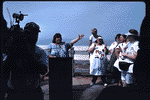 Later, as a husky DJ plays a pop-disco entrée, a British
photographer flashes away at a group that includes a supersize
starlet, Sherry Collins-Eckert, who's dressed like a Victorian
damsel. She's posing with NAAFA President Frances White. Collins-Eckert
agrees to a few more shots. But there's something frozen about
her demeanor as she insists that Don, her husband, stand next
to her.
Later, as a husky DJ plays a pop-disco entrée, a British
photographer flashes away at a group that includes a supersize
starlet, Sherry Collins-Eckert, who's dressed like a Victorian
damsel. She's posing with NAAFA President Frances White. Collins-Eckert
agrees to a few more shots. But there's something frozen about
her demeanor as she insists that Don, her husband, stand next
to her.
Supersize photographer Sandie Sabo, a several-hundred-pound woman
herself, had coached another photographer earlier not to snap
photos of large people from the ground. "Photographers think
that shooting from a low angle makes us look taller; it just makes
us look squattier, shows the shadows of the chins--not a bad thing,
just not flattering."
After the pose, the somewhat-reserved Collins-Eckert discloses
an earlier betrayal. The last time she was photographed for publication,
her bounteous body was pulled across the London Telegraph
to the edge of the frame and her husband was reduced to a mere
shadow. The image was sold elsewhere in Europe and Australia,
she says. Another NAAFA attendee's image ended up on a postcard
that's still being sold, with the caption, "Having a Whale
of a Time."
"It's a rear shot," Sally Smith recalls, "and
she has a very unique body type, so that everybody who looks at
it says, 'Oh, that's so and so.' "
There's also the image lifted for a pornographic film, with the
addition of cow and pig sounds.
"I can tell you 15 more versions of that happening to other
people," Collins-Eckert says bitterly.
THE CONCOURSE BALLROOM is packed with tables and racks
of merchandise, velvet capes, lacy negligees, supersize business
suits, towels, cat suits, pantyhose, big body clay sculptures,
super-large patterns, David Lee's generously large figures in
acrylics, and mounds of books with titles like Fat Girl Dances
with Rocks and Journeys to Self-Acceptance. The goods
have been carefully screened for the trade show to avoid any merchandise
from the diet industry.
Some manufacturers make enough booty from sales here and in their
hotel rooms to keep a low profile the remainder of the year. George
Glendenning, of Las Vegas, is looking a bit bored as he stands
beside his selection of lingerie, "Colesce Couture."
He wishes he'd brought more of the supersizes, which have nearly
sold out.
Will the sheer power of a majority in the marketplace raise size
acceptance to a new level? As odd as it seems, the bottom line
might become one of the largest human-rights enablers for the
Big Majority, in what fat-rights activists term one of the last
acceptable prejudices. Sales of big-women's fashions alone account
for a quarter of the entire women's apparel market. Sales in the
plus-size category were $23 billion last year, according to the
NPD Group, a New York-based marketing information company.
It's obvious, though, as the fat-acceptance movement hits a zenith,
the marketplace is increasing its niche: Online links connect
a network of people with Fat Art and Culture; single's parties;
Fat people's tours; Fat Fantasy date lines. There are countless
web pages listing attorneys who deal exclusively in size discrimination;
fat-sensitive physicians and fat-friendly massage therapists.
In some cities, such as L.A., San Francisco and New York, there
are for-profit parties. Ads run: "Big beautiful people and
their admirers" can enjoy each other in a "comfortable
non-judgmental atmosphere" for a $30 cover. Down the street,
Mor 2 Luv offers a dance, BYOB, entry fee: $22.
There are the raffish ads that critics say promote degrading
myths, such as super-big people want to be fed to grow bigger.
The classified ad with a photo caption for A Real FG (Fat Girl),
750+ pounds, reads: "Spend a day with me, from waking up
in the morning to going to sleep that night. Watch me eat three
full meals and a whole cheesecake for dessert while I walk a little,
and playfully move. "
It's this "feeder" fantasy that many say has banished
fat preference in people's minds to a bizarre fetish. Elaine Falevitch,
of Montana, wrote a letter to Dimensions magazine expressing
her concern about the otherwise useful magazine: "Bountiful
Productions, for example, advertises a videotape of 'Lollipop,'
using terms 'Big Belly,' 'Thunder Thighs,' 'Lard Legs.' As a fat
woman who has gone my whole life being called names, I am truly
and utterly offended by this."
SANDIE SABO AND Guy Russo specialize in photographing and
videotaping large models--no porn--through Russo Productions.
Their work appears in most of the large-women's magazines. The
San Diego couple drop down in two chairs between their convention
shoots. Sabo, the fashion editor of Dimensions magazine,
holds up their August bathing-suit cover. She says even within
the industry itself there's "rampant" discrimination
against 400-and 500-pound models. Women's magazines such as MODE,
Radiance, BBW (Big Beautiful Woman) and Belle
run photos of mid-size models, and the bi-monthly Dimensions
is the only one that regularly runs photos of supersize women.
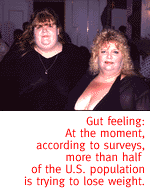 A NAAFA member for 21 years, Russo is tall and what would be
considered somewhat average size, hovering around six feet. As
a teenager, he hid his big-girl preference and says he regrets
that he didn't date large women. He had pin-ups of big women in
his locker, says Sabo. Russo still has the original Dimensions
publication that Conrad Blickenstorfer began as a 10-page Xerox
13 years ago as a lifeline for "fat-admiring" (FA) men.
Now, in addition to light nudity, the magazine contains everything
from a health column written by a 500-pound emergency-room physician
to articles covering issues such as how parents view their fat
kids.
A NAAFA member for 21 years, Russo is tall and what would be
considered somewhat average size, hovering around six feet. As
a teenager, he hid his big-girl preference and says he regrets
that he didn't date large women. He had pin-ups of big women in
his locker, says Sabo. Russo still has the original Dimensions
publication that Conrad Blickenstorfer began as a 10-page Xerox
13 years ago as a lifeline for "fat-admiring" (FA) men.
Now, in addition to light nudity, the magazine contains everything
from a health column written by a 500-pound emergency-room physician
to articles covering issues such as how parents view their fat
kids.
Russo's participation in the Fat Admirer's SIG is more as a mentor
for people coming out about their "size orientation."
With the pervasive societal prejudice against fat people, psychologists
say, FAs are often erroneously considered abnormal. (Of course,
not all people with fat partners necessarily have the preference.)
While scientific studies on large-size preference are scarce,
there are fewer heterosexuals, at least, who prefer the very thin
or the very fat. Consequently, some lack the courage to appear
with their big partners in public. Others observe that in this
society, it's infinitely easier for women who have preferences
for fat men.
"This is what I find attractive for me," says Russo,
motioning, almost vehemently, with an outstretched arm to the
confident blonde-haired Sabo. "It may not work for other
people. This is, genetically or otherwise, what is instilled in
me."
Leaders of the Couples and the Fat Admirer's SIGs, compare their
social experience to that of mixed-race couples. Bob and Linda
Sponaugle, of Atco, New Jersey, have been married 10 years, and
yet, still, Linda has not met Bob's parents, who live only three
hours away. "They want nothing to do with me," says
Linda, the chairwoman of the Mid-Size SIG.
Laura and John Baker, from Santa Barbara, say they suffer similar
discrimination from his family. And then there are the "buddies":
While the Bakers don't need to maintain an upwardly-mobile facade
that might be required at Fortune 500 firms, says Linda, her husband's
engineering colleagues ask the dashing, 5-foot-11 John,
" 'So what is it about a large-size woman that you're attracted
to?' It's rude," says Laura, a Super-Size SIG member. "I
don't think his officemates have asked each other why do you like
women with dark hair or red hair or skinny women. It's not a question
that's usually asked. That's what we're trying to do in NAAFA
is take that stigma out of it."
"These poor guys," says Sabo, a self-described "super-size,"
"they've almost taken a worse rap than fat people. There
are no closets for fat people. But with these guys, dealing with
the issues with their families, the people they work with. It's
infinitely easier to hide."
It's those societal prejudices, says Russo, that make the NAAFA
socials so necessary. "Where else can a man go and see all
these attractive women in one place at one time," he says
of the convention, as a stream of vigorous women step off a nearby
escalator on their way to an aerobics class. "When plus-sized
women go out in public, they're given the message that they're
not attractive," he says. "If a man compliments them,
they're looked at suspiciously. 'What do you want?' They're not
going to take it seriously. Outside something like this, it's
hard to develop social interaction where everybody's comfortable.
Here, you know the games are left outside, and this is who we
are."

|
 |





